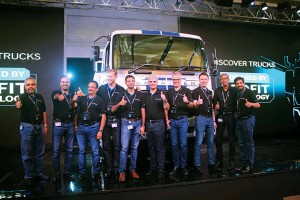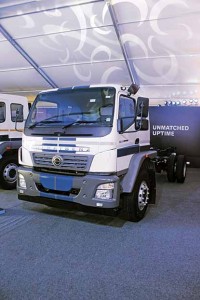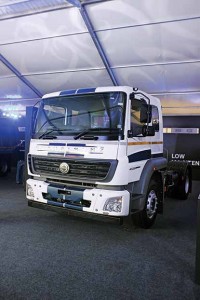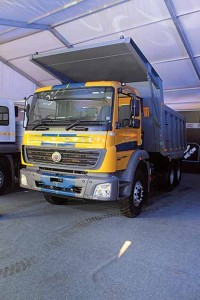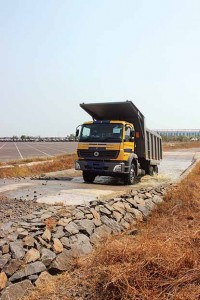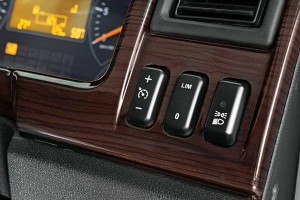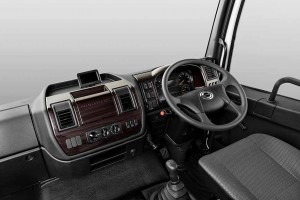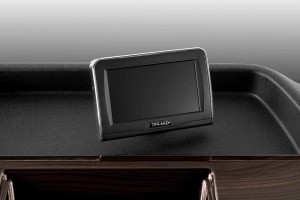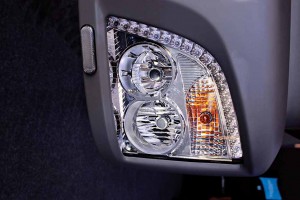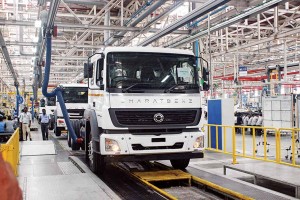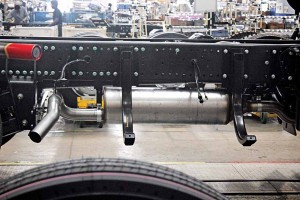Daimler India Commercial Vehicles has developed SCR technology for its CVs to comply with the BSIV emission regulations, sans a price hike.
Story & Photos by:
Ashish Bhatia
The words ‘Profit Technology’ are doing the rounds at Daimler India Commercial Vehicles (DICV). They concern the move up to BSIV commercial vehicles – trucks, which the company unveiled recently at Chennai. Also termed as HDTs, the trucks claim to deliver best-in-class productivity, efficiency and safety. Promising low cost of ownership, what the BSIV BharatBenz HDTs best offer perhaps is the lack of price differential between them and their BSIII breathrens. There’s been no price increase with the move to BSIV. Expected to provide DICV a solid advantage, the BSIV HDTs hint at a technological leap that reflects upon Daimler’s long standing experience in building trucks the world over, and the frugal engineering abilities that India has come to be known for. Flaunting a local content of upto 85 per cent, and supported by over 400 suppliers, the BSIV BharatBenz HDTs point at a distinct ‘value proposition’. Announced Erich Nesselhauf, Managing Director and Chief Executive Officer, that the company planned much before the BSIV mandate was enforced. Left with 200 BSIII CVs, the company is confident of gaining an edge.
SCR for BSIV compliance
Even as the 31-tonne GVW 3123 8×2 rigid haulage truck took the centre stage at Chennai, Nesselhauf drew attention to having sold more than 1000 BSIV trucks since August 2015; much before the enforcement of pan-India BSIV emission norms on April 01, 2017. Out of the range of HDTs, from 16- to 49-tonne, the 3123 flaunted a 60-litre AdBlue tank as part of its BSIV hardware. Powered by the 235 hp, 6372 cc, six-cylinder engine, the truck came fitted with a SCR exhaust gas after-treatment. The SCR has NOx sensors at the core of it apart from the AdBlue injector nozzle. The system is controlled by an ECU, and the AdBlue solution – made of Urea, is sprayed into the exhaust gas stream, with the NOx sensors sensing the amount of reduction in nitrogen oxide emissions as per the prescribed BSIV emission norms. What comes out of the tail pipe is harmless nitrogen and water. The BSIV trucks that DICV is offering, are claimed to have been tried and tested internationally. They are robust according to Nesselhauf. Drawing attention to the NOx sensors, which are indicative of the higher electronic content the BSIV trucks have come to carry, Nesselhauf explained, “Harnesses, sensors, electronic bits and software were added.”
Promising significant increase in fuel-efficiency, the BSIV BharatBenz trucks were subjected to weight shaving of upto 400 kg to compensate for the weight of the BSIV hardware. Claimed to weigh as much as the BSIII CVs did, the BSIV HDTs, according to Nesselhauf, are set to transform the commercial vehicle segment.
Operational support
Other than the 3123, the BSIV BharatBenz HDTs the company is offering, include the 1617, 2528 and 4023. Their AdBlue reservoirs (as part of the SCR system) will need to be topped-up at long intervals. For this, the company has made requisite arrangements at its dealers. It has also tied up with petrol pumps. Supply of quality Adblue solution is essential. Any compromise in quality may lead to the truck going into a limp mode, affecting operational efficiency as well as performance and emissions. It is this very aspect that links the reliability and performance of BSIV trucks rather closely with that of the dealers. With considerable uptake in electronics, DICV, it is not surprising, has invested in time and resources to bring its dealer network up to speed. Averred Nesselhauf, “We urged our dealers to look at areas of gain.” DICV also undertook upon itself to educate and address the concerns of its customers, both existing as well as new. Said Nesselhauf, “With fuel saving of 10 per cent, a fleet owner stands to save 1000 litres annually on each truck that he operates for 18,00,000 kms. In terms of pure carbon savings per litre of diesel, BSIV engines result in carbon emission reduction of 2.5 kg per litre. Significant savings are also achieved in the case of NOx emissions.” He opined, “It is the inefficient engines, which are a cause of global warming among others. Special focus was laid on optimising engines while moving to BSIV.”
Face-lift
DICV has utilised the opportunity to treat its trucks to a face-lift as part of the move upto BSIV. The trucks now feature a bold new face. The grille has got bigger and wider; there are LED DRLs built into the head lamp assembly. The bumper is body coloured on higher spec models. DICV has also added a host of new features to turn its trucks into a better value proposition. With ABS standard on BharatBenz trucks since 2012, new features like auxiliaries have found their way into the truck. Aerodynamic improvements have been carried out, and also efforts to reduce friction. In an effort to reduce driver fatigue, the trucks come with ‘cruise-control’. The head lamp design with built in LED DRLs is claimed to offer better visibility. The higher spec models come with a reverse camera. Advocating the deployment of AC in truck cabins, the BharatBenz BSIV trucks come with AC as optional. A brief drive revealed the difference in how the BSIV truck feels over the BSIII version. If an improvement in NVH is noticeable, the 2528 construction truck felt as capable and pro-efficient as its BSIII brethren. A differential lock buzzer in the cab indicated the engagement of active differential lock as the truck drove on an earthern path with hurdles. An interesting feature the BSIV BharatBenz trucks come with is the fuel-theft protection device.
Digitisation
To go with the higher electronic content on the BSIV BharatBenz trucks, DICV is working to streamline processes. Seeking feedback from owners, operators and drivers to improve products and services, the company has devised a mobile application, ProServ. The ProServ app. enables customers to analyse vehicle data or access maintenance instructions. Sales and customer service representatives across the brand’s network have access to all relevant information as well. This equips them to provide effective consultation and support to customers. Averred Nesselhauf, “We have trained our dealers to deal with BSIV vehicles.” Apart from training, the dealer staff is supported by an online technical information platform called Ascent (After Sales Central). It is a multilingual, animated system to facilitate information access at all DICV service centres. In addition, mobile service workshops, claimed DICV sources, are equipped to reach out in case of an emergency (in four hours flat). Customers can reach out to the company network through a 24×7 helpline number.
Future ready
With attention to the future, DICV is keen to double its market share in HDTs. Said Nesselhauf, “We are future ready.” He is of the opinion that the implementation of GST in July will eliminate inefficiencies in the transport industry. In the wake of the global headwinds and the slowing down of many markets in the world, India, it is not surprising, is assuming greater importance in the scheme of things at Daimler. A big chunk of CVs made at DICV’s Chennai plant are exported to over 14 markets under the Fuso brand. It is the DICV built HDTs that have led to a change in Fuso’s perception. Fuso is now being increasingly looked at as a heavy-duty truck brand. As a matter of fact, averred Nesselhauf, that they are confident of the new range boosting volumes. A big draw is the price, which has not increased despite the additional BSIV hardware that has been incorporated. In 2016, DICV sold 13,100 trucks as compared to 13,997 numbers in 2015. To further strengthen its position and market reach, the company could soon launch a sub-nine tonne (seven-tonne) truck for the export market. The Indian market launch is expected to happen sometime later.
Shaving weight to compensate for BSIV hardware
To enhance the performance and comply with BSIV emission norms, DICV, to fit an exhaust gas after-treatment (SCR), resorted to light weighting. The engineering team went through the entire truck; analysed every nut and bolt to achieve weight reduction of upto 400 kg. The team turned to value analysis. Functions of different parts were analysed. Material analysis was carried out. The exercise, expected to shave up to 300 kgs on lighter trucks, led the team to choose materials that would balance cost and weight. Material and design changes played a crucial role, and also the non-load bearing members. The grade of material was improved to facilitate a reduction in thickness, and in-turn weight. Without sacrificing performance or reliability, weight reduction was achieved through the use of superior grade material. In many application areas, the use of ‘Domex 650’ high strength steel was resorted to. This steel grade is used by many body builders to build containers in North India, and leads to substantial weight saving. The Domex cold forming steel the company is claimed to have used, is thermo-mechanically rolled. Its heating, rolling and cooling processes are carefully controlled.
To increase fuel efficiency, DICV compartmentalised the function of engine and the after-treatment system. SCR was chosen since it reduces the engine effort to meet tighter emission norms. With the chemical process limited to the after-treatment system, the SCR is often looked upon as an advanced active emissions control technology system that injects AdBlue into the exhaust gas stream while the engine is operating. Reducing (Nitrogen Oxide) NOx emission primarily, the SCR helps to achieve better fuel efficiency by putting hardly any burden on the engine. Engine performance is thus not compromised. Nitrogen Oxide (NOx) flows into the SCR system for reduction reactions to take place in an oxidising atmosphere. SCR reduces the level of NOx using ammonia as a reducing agent within a catalyst system. For the chemical reaction Diesel Exhaust Fluid (DEF) is used as a reducing agent that reacts with NOx to convert the pollutants into nitrogen, water and less amount of CO2. DEF also enables the engine to use less EGR and higher oxygen levels for better combustion. With the use of SCR, NOx can be reduced by up to 90 per cent. The system, it is clear, seeks a balance between fuel efficiency and emissions.
_ Bhargav TS



